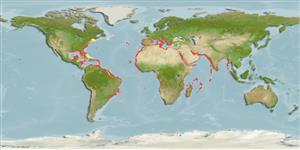Cephalopoda |
Octopoda |
Octopodidae | Octopodinae
Environment: milieu / climate zone / تغييرات عمق / distribution range
بوم شناسي
; تغييرات عمق 5 - 200 m (مرجع 275). Tropical; 46°N - 28°S, 96°W - 96°E (مرجع 275)
Atlantic, Indian Ocean and the Mediterranean.
Length at first maturity / Size / Weight / سن
بلوغ: Lm ? range ? - ? cm Max length : 9.0 cm ML جنس نر / بدون خواص جنسي; (مرجع 417); بيشينه وزن گزارش شده: 56.40 g (مرجع 123036)
Minimum depth from Ref. 83938. This is a subtidal species found in sandy-muddy bottoms (Ref. 83938).
Life cycle and mating behavior
بلوغ | تولید مثل | تخم ریزی | Eggs | Fecundity | Larvae
Members of the class Cephalopoda are gonochoric. Male and female adults usually die shortly after spawning and brooding, respectively. Mating behavior: Males perform various displays to attract potential females for copulation. During copulation, male grasp the female and inserts the hectocotylus into the female's mantle cavity where fertilization usually occurs. Life cycle: Embryos hatch into planktonic stage and live for some time before they grow larger and take up a benthic existence as adults.
مآخذ اصلی
مراجع | هماهنگ كننده | همكاران
Schneider, W. 1990 FAO species identification sheets for fishery purposes. Field guide to the commercial marine resources of the Gulf of Guinea. Prepared and published with the support of the FAO Regional Office for Africa. Rome: FAO. 268 p. (مرجع 417)
وضعيت در فهرست قرمز IUCN
(مرجع 130435: Version 2025-1)
وضعيت از نظر سايتس (مرجع 108899)
Not Evaluated
Not Evaluated
خطر برای انسان ها
استفاده انسانی
| FishSource |
ابزارها
اطلاعات بيشتر
Life cycleتولید مثلبلوغFecundityتخم ریزیEggsنمو تخمLarvae PhysiologyOxygen consumption
Human RelatedStamps, coins, misc.
منابع اينترنتي
Estimates based on models
Preferred temperature
(Ref.
115969): 14 - 27.6, mean 23.6 (based on 762 cells).
Fishing Vulnerability
Low vulnerability (10 of 100).
